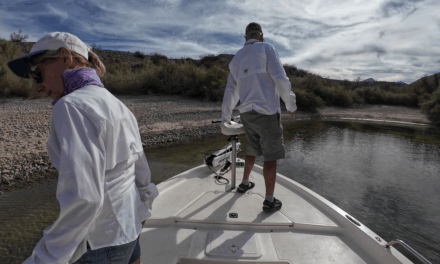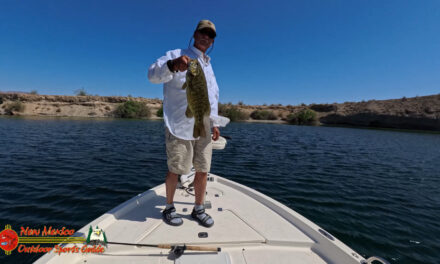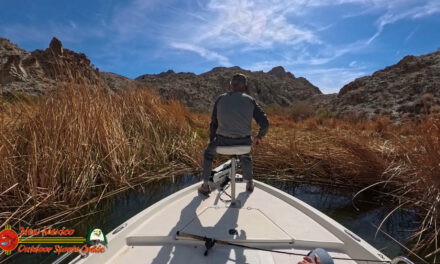ATHENS, Texas—When the Texas Legislature named the Guadalupe bass the state fish of Texas in 1989, it did so because of the fish’s distinctive nature. Found nowhere else in the world outside the San Antonio, Guadalupe, Colorado and Brazos river systems, the Guadalupe bass exemplifies the qualities and resources of the Texas Hill Country.
Ironically, the same conditions that developed the Guadalupe bass also made it vulnerable to change.
Two main factors have led to a decline in the number of Guadalupe bass: habitat loss and hybridization with introduced smallmouth bass. The latter has been by far the more serious.
“These fish lived so totally separated from each other that they never developed mechanisms to avoid hybridization,” said Gary Garrett, Ph.D., a Texas Parks and Wildlife Department fisheries biologist who has studied the problem for the last decade at TPWD’s Heart of the Hills Fisheries Science Center near Ingram.
Following the stocking of smallmouth bass into Hill Country streams beginning in 1974, scientists began finding hybrids resulting from interbreeding between the two species.
“We didn’t know it was going to happen,” Garrett said. “We became concerned, and I took on research into the problem as part of my job in the mid-1980s. We did a wide-range survey and found the problem was more serious than we thought. About 30 to 40 percent of the fish were already hybridized.”
“As soon as we found out hybridization was occurring, we began moving to try and reverse the process,” said Phil Durocher, director of TPWD’s Inland Fisheries Division.
“The first thing we did was prohibit any further stocking of smallmouth bass into the native range of the Guadalupe bass to make sure things didn’t get worse. Secondly, we began looking at producing and stocking Guadalupe bass to reverse what had already occurred. Dr. Garrett has led those efforts.”
TPWD biologists decided the best approach was to fight fire with fire by stocking Guadalupe bass in such numbers that their offspring would overwhelm the hybrids. That approach presented its own difficulties.
“First we had to figure out how to raise a riverine fish adapted to living in fast-flowing streams in a hatchery environment,” Garrett recalled. “A muddy bottom and still water didn’t work. Our hatchery expert, Bobby Wienecke, came up with a modified nesting box we called Guadalupe bass condos. His idea was that the fish wanted to be shaded, since they tend to hang around cover such as large rocks, cypress roots and stumps in the wild. So he built boxes with screened bottoms, filled them with gravel and put a roof over them supported by two posts. The fish took to them immediately.”
TPWD began stocking hatchery-raised Guadalupe bass in 1992. Luckily, the ideal test site ran right by Heart Of The Hills: Johnson Creek. Hybrid bass had spread from the Guadalupe River up into the lower reaches of the creek, but none had yet penetrated far upstream. “We found that for the first five or six years, we didn’t seem to be having much of an impact,” Garrett said. “What was happening was that we were pouring large numbers of fish into the creek, and they were moving out into the river. That diluted the effect in the creek, but it spread it over a much larger area, and it took longer to have an effect than we anticipated.”
In retrospect, Garrett says, nature was pointing the way to success. “If we had been stocking Guadalupe bass into all arms of the river all along, we would be much farther down the road than we are now.”
Stocking the main stem of the river and its north and south arms, however, would require more fish than Heart Of The Hills could produce.
“Tripling the number of Guadalupe bass produced would put a strain on the hatchery system,” Garrett said. “Fortunately, in the last two or three years a number of things have happened that now make it possible. A cooperative effort by TPWD, the Upper Guadalupe River Authority, Hill Country Fly Fishers, Southern Council of Fly Fishers, Texas Association of Bass Clubs, the Federation of Fly Fishers and the Kerrville Convention and Visitors Bureau will enable us to stock up to 225,000 Guadalupe bass fingerlings each year for the next five years.”
One other piece of the puzzle that fell into place was the availability of pond space at the federal fish hatchery in Uvalde.
“The Upper Guadalupe River Authority is seeking grant funds to pay for the fish from the federal hatchery,” Garrett explained. “Our department will continue to produce 75,000 fish each year, and the grant will purchase 150,000 annually from the federal hatchery. Thus there is no increase in cost to TPWD.”
“This program is important to us, and we want to thank everybody who is helping,” Durocher said.
Garrett looks forward to the day when Guadalupe bass once again reign supreme in the Hill Country streams that gave them life.
“I expect we will be able to reduce hybridization to near zero if not zero,” he said. “It’s going to be very hard to do, but we’re not going to walk away from this. If we can get the rate of hybridization to near zero, I think nature can finish the job from there.”
In yet one more twist, the same traits that let the Guadalupe bass develop, and made it vulnerable to hybridization, will ultimately prove to be its salvation.
“These fish are adapted to whatever it is that makes Hill Country streams unique,” Garrett said. “They are able to out-compete other species, including the hybrids. Once we get the situation stabilized, these fishes’ special characteristics will let them hold their ground.”
Although they never get very large—the state and world record is 3.69 pounds—Guadalupe bass are a popular sport fish. Fishing for these agile, scrappy fish in fast-flowing waters is said to be similar to fishing for trout in mountain streams.
Anyone who has ever fished for Guadalupe bass in scenic Hill Country streams that remain the most pristine rivers in Texas can appreciate one other quality of the fish. “One of the nicest things about Guadalupe bass is you can’t catch one in an ugly place,” Garrett said. “That alone makes them worth saving.” – Lake Mohave
– Lake Mohave






